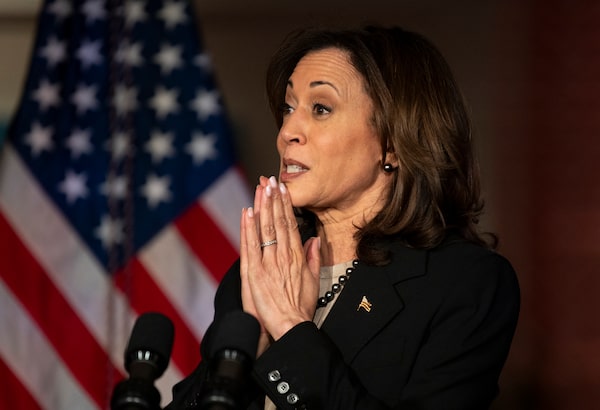
US Vice President Kamala Harris speaks at Women for Biden campaign event in Saint Paul, Minn. on March 14.STEPHEN MATUREN/Getty Images
Kamala Harris entered the White House with heady expectations. A former California prosecutor navigating a meteoric ascent through the American political firmament, some foresaw the makings of a rare talent, a combination of temperament and skill likened to Democratic Party icons Barack Obama and Elizabeth Warren.
It wasn’t long before the comparisons grew less flattering. After struggling to leave a mark in her first few years as Vice-President, one observer suggested Ms. Harris better resembled Ron DeSantis, the Florida Governor who wilted on the national stage. The Los Angeles Times called her “the incredible disappearing vice-president.”
But as she seeks four more years in office alongside a President whose age has raised the actuarial possibility that he may not survive another term, expectations have once again risen for Ms. Harris. She is, supporters believe, strong where Joe Biden is weak, a woman who has spent nearly four years learning the levers of government and finding more confident places to politically assert herself.
“If Biden’s greatest political challenge this year is remotivating a disaffected Democratic base, she’s by far the best-positioned individual to help him pull that off,” said Dan Schnur, a long-time California political strategist who is a professor at the Institute of Governmental Studies with the University of California at Berkeley.
Now that Mr. Biden and Republican Donald Trump have both sewn up their party nominations, the general election campaign has effectively begun – one in which Mr. Biden is, according to most polls, starting from behind.
Normally, Prof. Schnur said, running mates “don’t make much difference in elections. But most presidential candidates aren’t in their 80s. So for actuarial reasons alone, Harris is bound to have a much greater impact on this campaign than most vice-presidential nominees do.”
A new role for Ms. Harris has already begun to come into view. After struggling to address the migration crisis – pilloried by Republicans as a failed “border czar” – she has become one of the Biden administration’s most outspoken voices decrying abortion curbs.
On Thursday, she toured a Minnesota abortion clinic, the first time a sitting vice-president or president has made such a visit, and spoke out against what she called a health crisis “affecting many, many people in our country, most of whom are, frankly, silently suffering.”
She has also been dispatched to deliver messages on some of the thorniest foreign-policy issues, promising Ukrainian President Volodymyr Zelensky “we will be with you for as long as it takes,” while calling for a temporary ceasefire in Gaza, where she decried the scale of “humanitarian catastrophe.”
In the campaign for the November election, Mr. Biden’s political fate, of course, lies largely in his own hands.
“When people walk into the voting booth, they are almost exclusively focused on the top of the ticket – who am I going to pick for president – not who am I going to pick for vice-president,” said Jim Margolis, a political consultant who was media adviser to Ms. Harris in her presidential campaign.
Still, for a sitting President entering the campaign with approval ratings that are among the worst of his term, there are evident areas for Ms. Harris to contribute. Some polls, for example, show Hispanic voters shifting toward Mr. Trump, after voting in considerable numbers for Mr. Biden in 2020.
She “is going to play a major role in the campaign – and she should,” Mr. Margolis said. “Right now, the President and Vice-President are not performing as well as they need to with some of the key voter groups that are essential to winning in November.”
He pointed to lower levels of support among voters who are Black, Latino, younger or have lower levels of education, particularly relative to where those groups stood four years ago.
“These groups are precisely the demographic targets that Vice-President Harris is best suited to move,” he said. “I think you will see her spend the next seven months on college campuses, in Black churches, in the Latino community and with women voters trying to generate enthusiasm” – and raise the risks of a second term for Mr. Trump.
“This is her sweet spot,” Mr. Margolis said.
Dim evaluations of Ms. Harris as Vice-President, however, raise the question of how effective she is likely to be in such a capacity. A weekly YouGov public-opinion tracker has found her favourability rating among registered voters has fallen below 40 per cent, while more than 55 per cent hold an unfavourable opinion of her. She fares considerably better among younger people, and marginally better among women and Hispanic voters.
She is popular among Black voters, with nearly 70 per cent expressing approval.
Ms. Harris was born to a Black father and Indian-American mother (and spent part of her adolescence in Montreal).
Her challenge is to broaden her appeal, said Mike Madrid, who leads Grassroots Lab, a California campaign management and lobbying company.
“She isn’t simply running for vice-president. She has to overcome the very real, very legitimate questions about her capacity to lead the country and the world,” he said. “She’s facing a foundationally different set of circumstances than any vice-president in modern memory.”
Mr. Madrid recently began rereading Truman, the biography of the 33rd president by David McCullough. That history, he says, may be instructive. Mr. Truman was deeply underrated, “viewed as this bumbling Midwesterner who was uneducated” and named as vice-president “because they didn’t have anywhere else to put him.”
When Franklin D. Roosevelt died, Mr. Truman became president at a crucial time in history, as a new global order was being established.
“It’s eerily similar to what we’re seeing today,” Mr. Madrid said.
Ms. Harris, he said, “suffered from being successful in the monoculture of California politics,” dominated by the Democratic Party, which faces little meaningful opposition. She is not known for a gleaming charisma nor for being quick on her feet; Republicans once released a video compilation of her discussing Venn diagrams.
Although she has appeared on 60 Minutes and spoken to the New York Times, she has tended toward interviews where she is unlikely to face intense questioning. These include a chat last year with People magazine – which reported that she enjoys picking tarragon from her garden – and another with Katie Couric earlier this year, in which she described her height while wearing heels.
“She does not inspire confidence. She just doesn’t,” Mr. Madrid said. “That doesn’t mean she can’t. It just means she hasn’t to this point.”
Her perceived weaknesses have already made her a favoured object of attack by the right. Mr. Trump has mocked her speaking style; Ms. Haley, before ending her campaign, invoked the woman who is first in the line of succession as a nightmare in waiting, saying, “we can’t afford a President Kamala Harris.”
Polls have shown Mr. Trump winning new favour among male voters, including Black men. Radio host Charlamagne Tha God, a key supporter in 2020, has publicly distanced himself from her, lamenting to Politico earlier this year that she “kind of disappeared” once entering the White House.
But Ms. Harris has shown strength in addressing abortion, and Democrats are making the reversal of Roe v. Wade a major campaign issue.
“She’s a natural fit,” said Chuck Rocha, a Democratic Party strategist who has advocated for Latino involvement in elections.
“They should have her out there as much as they can,” he added, “because there’s no way Joe Biden is going to be the president without a robust women’s vote.”
 Nathan VanderKlippe
Nathan VanderKlippe